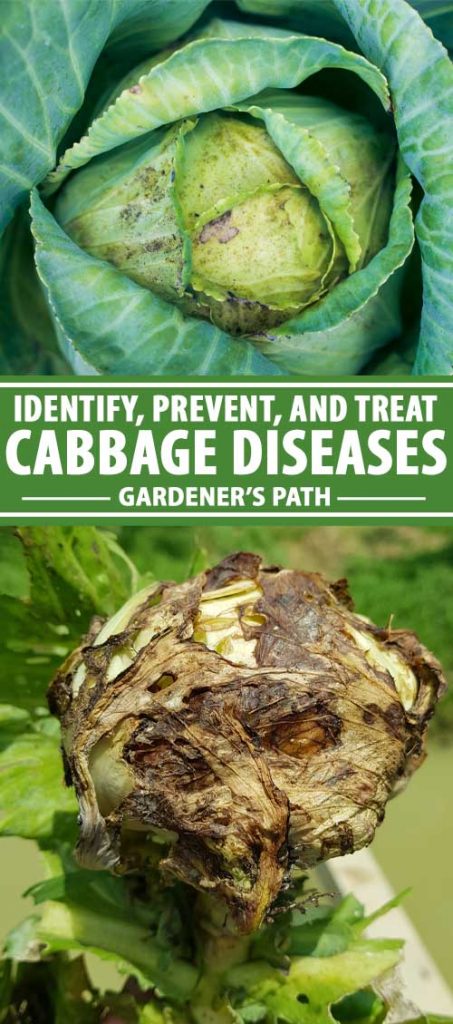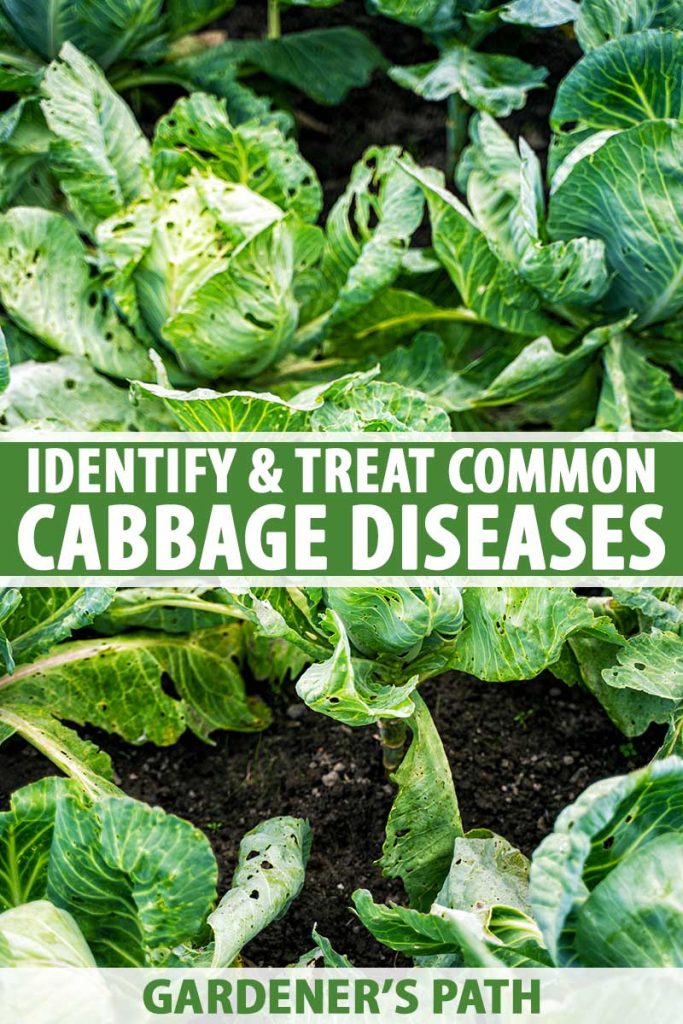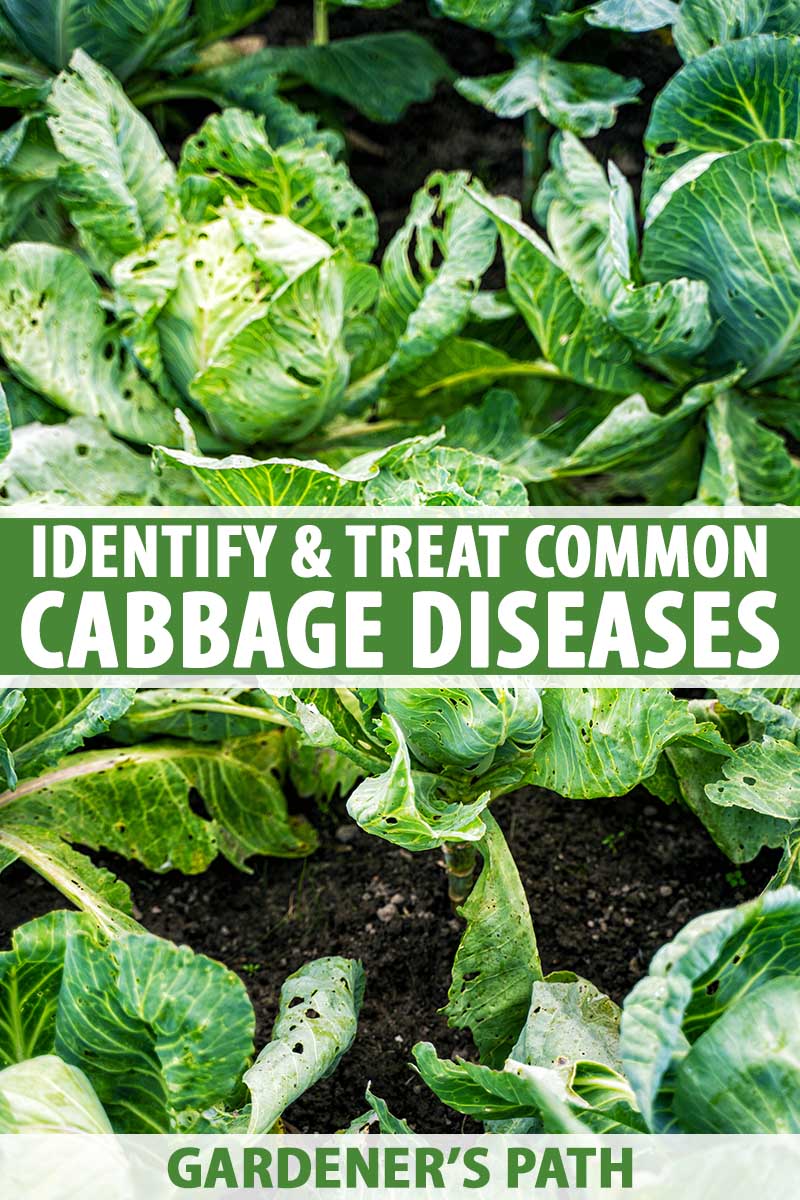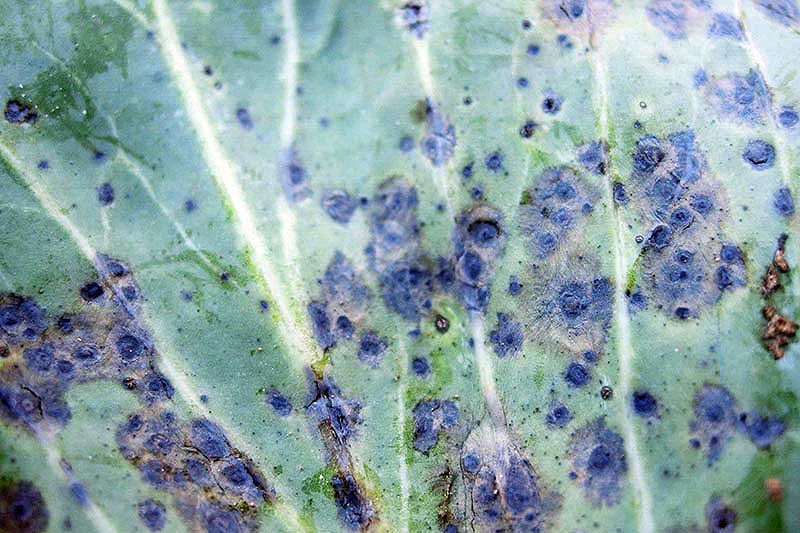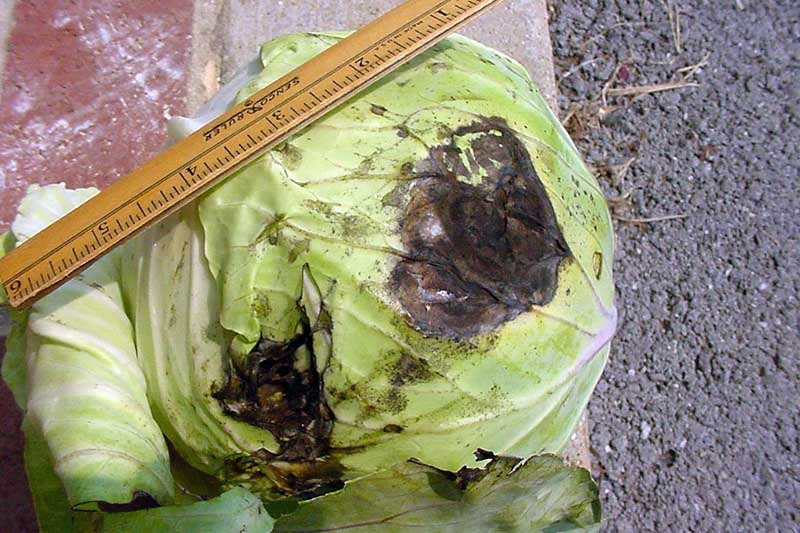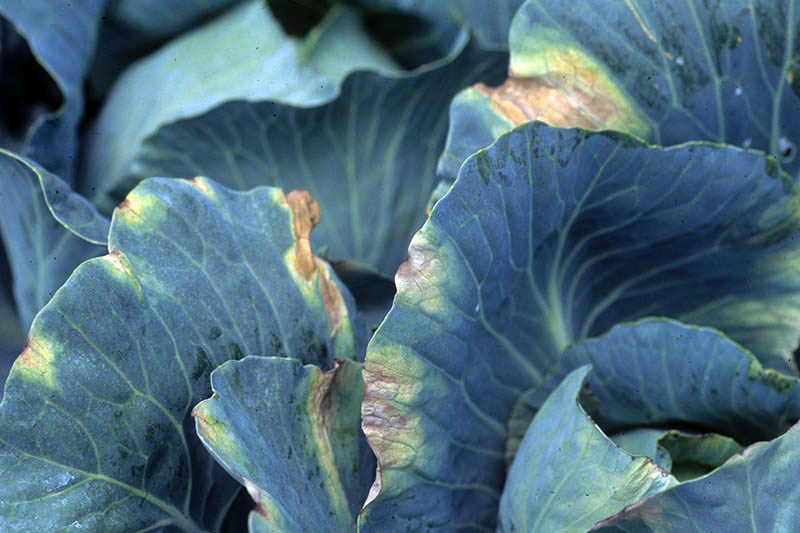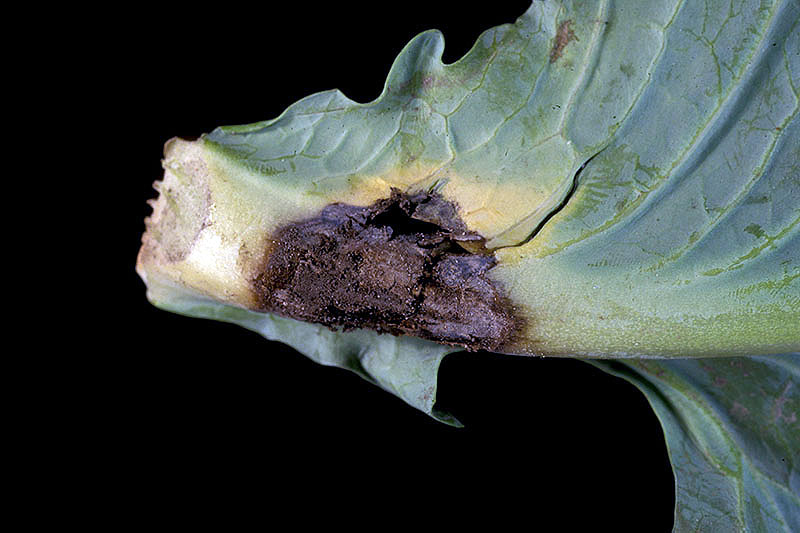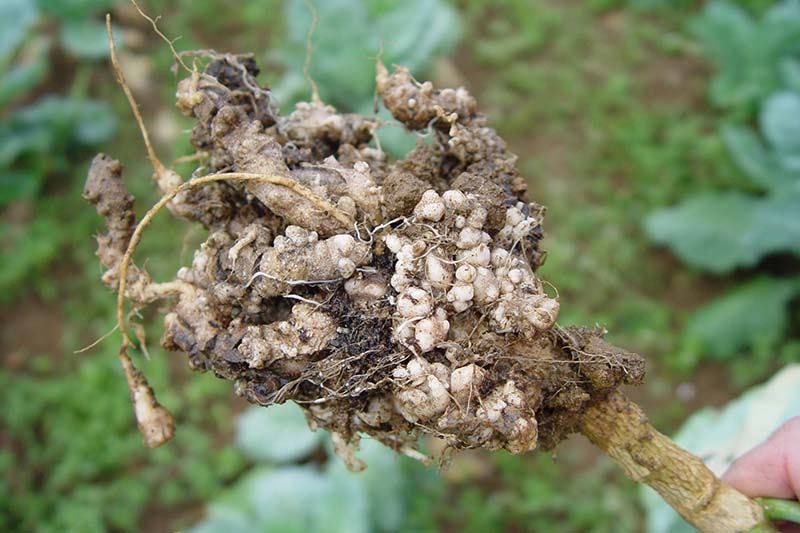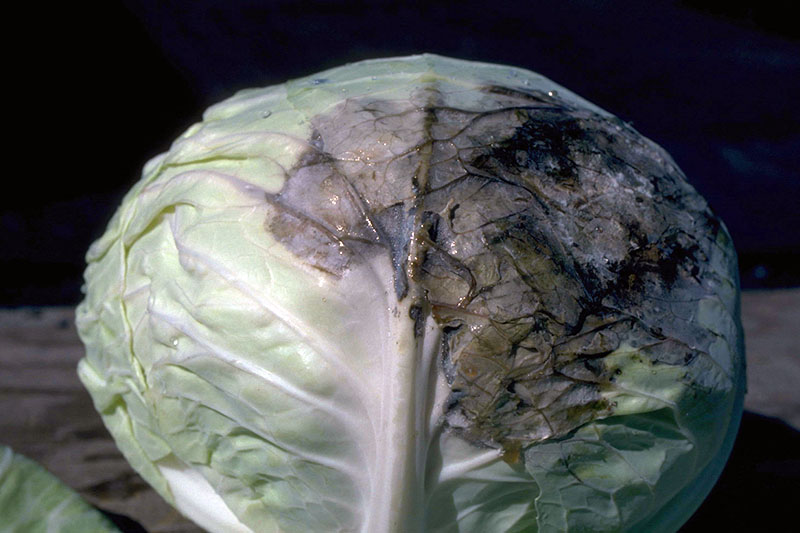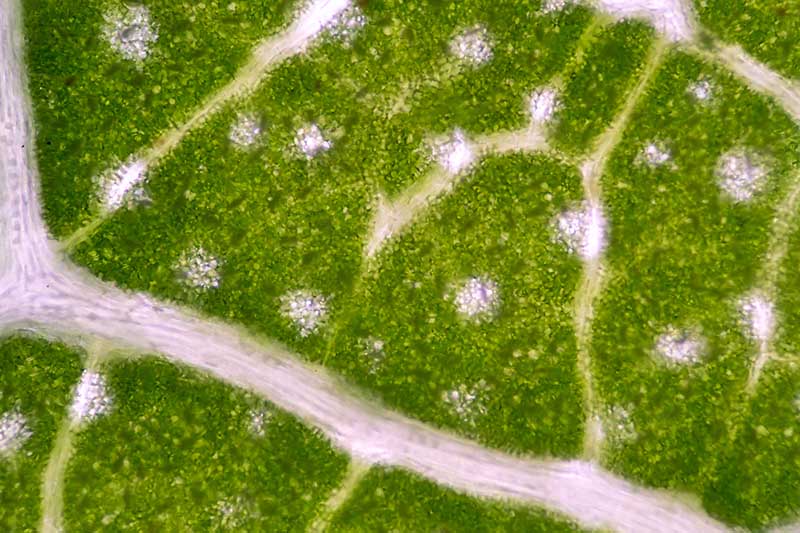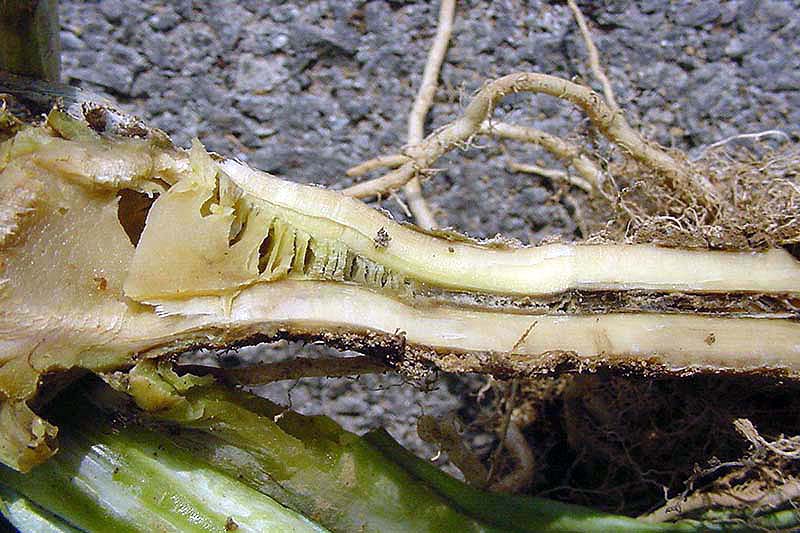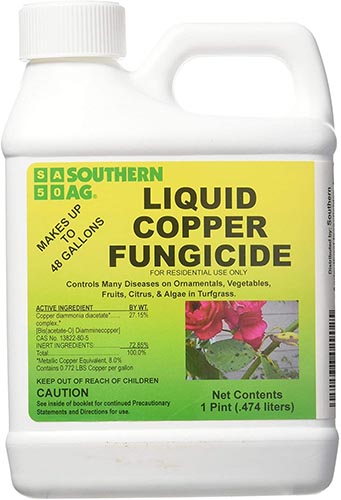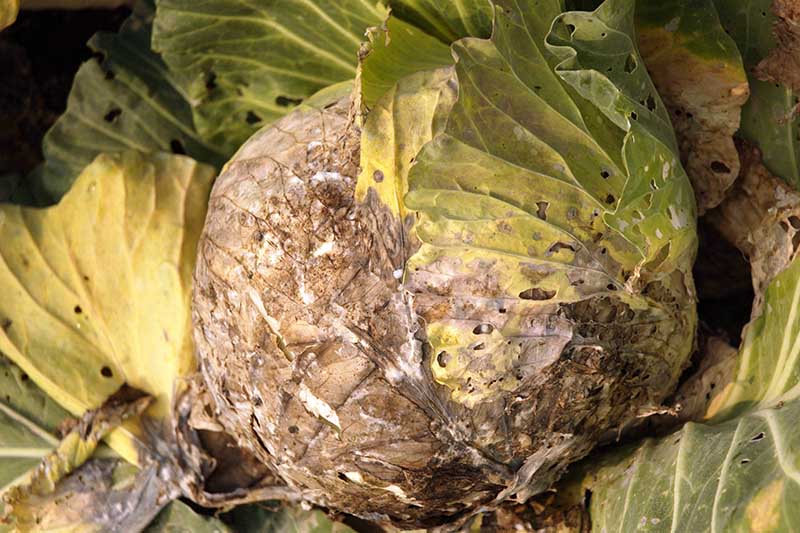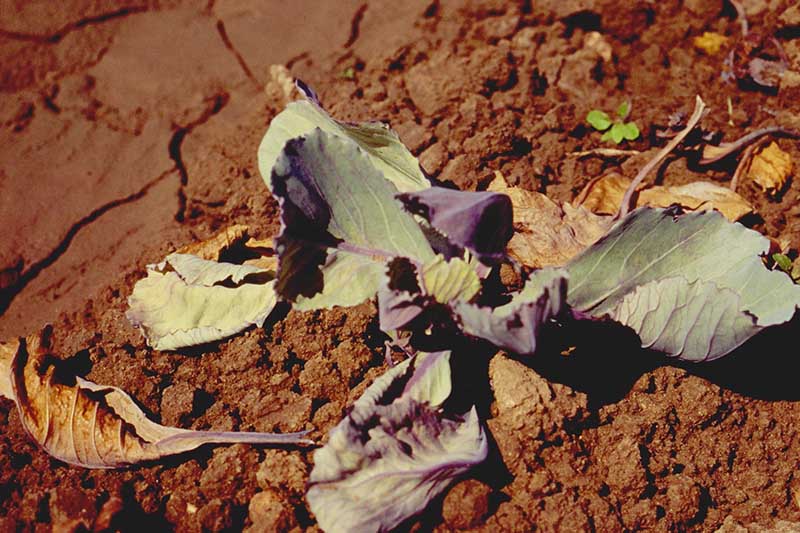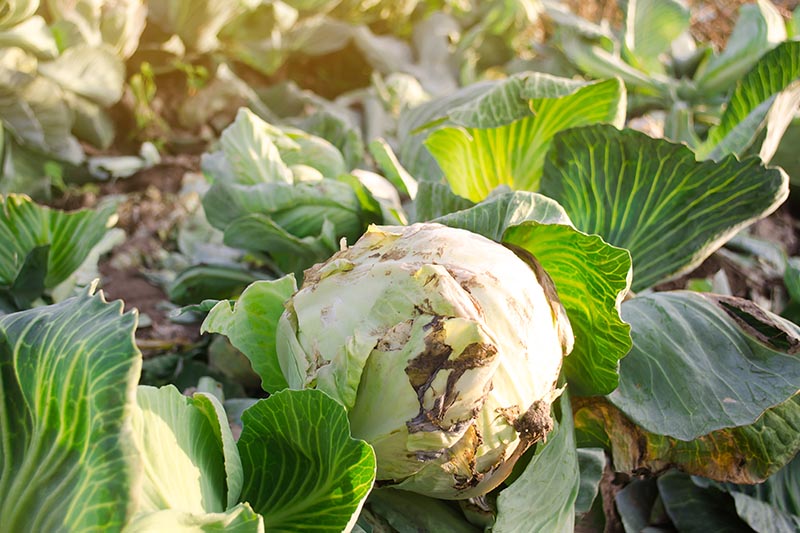The infections can range in severity from the unsightly but not usually fatal, such as powdery mildew, to the almost uniformly fatal bacterial soft rot. Some of these pathogens live in the soil where they can readily attack the roots of your crop, and many others lurk in the cruciferous weeds growing nearby. We link to vendors to help you find relevant products. If you buy from one of our links, we may earn a commission.
1. Alternaria Leaf Spot
Alternaria leaf spot is caused by two species of fungi, Alternaria brassicicola and A. brassicae. Both species are well known for causing leaf spots to develop on older tissue, but these fungi can also infect the base of the developing heads. Alternaria is more likely to cause disease when moisture is present on the cabbage, and temperatures range from 68 to 81°F. Symptoms include yellow spots that grow larger and develop rings around them like a target or bull’s-eye. As the tissue dies, the centers may fall out, resulting in holes in the foliage. As the disease develops, the spots join together to form large areas of dead tissue. Controls for Alternaria leaf spot start with good cultural practices. These include the use of drip irrigation, sanitizing your gardening tools, rotating your crops, and removing all dead plant material at the end of the growing season. Biopesticides that may prove effective in the case of an outbreak include Bacillus amyloliquefaciens and Bacillus subtilis.
2. Bacterial Leaf Spot
There are two different species of bacteria that can cause bacterial leaf spot in cabbage, Pseudomonas syringae pv. maculicola and Xanthomonas campestris pv. armoraciae. P. syringae pv. maculicola can infect all types of cole crops. It causes spots to form on the leaves that start out small, becoming dark brown or purple as they increase in size. These spots can join together to form angular lesions, which make the leaves look ragged. In the case of a severe infection, the foliage can die. Unfortunately, this form of bacterial leaf spot is readily spread by splashing water, including irrigation water, and by insects. This disease is most prevalent during periods of cool, wet weather. In contrast, X. campestris pv. armoraciae is more likely to cause infections in warmer temperatures. Initial symptoms include dark flecks on the leaves that spread into lesions. The centers often degrade with time, resulting in circular holes in the foliage. Prevention and control efforts range from planting heat-treated seed to irrigation practices that minimize the amount of moisture that comes in contact with the foliage. Crop rotation is also critical in subsequent seasons, as the bacteria can overwinter in the soil.
3. Bacterial Soft Rot
Bacterial soft rot is caused by the the bacteria Pectobacterium spp. (formerly Erwinia) and can result in losses in a tremendous number of crops, including cabbage. In fact, it is one of the most damaging plant diseases known throughout the world. Cabbages can show symptoms in the field, but the majority of infections occur during storage. The first signs of infection are small lesions that appear water soaked. They quickly enlarge, and infected plant tissue turns brown and mushy. Frequently, the whole plant may decay. The bacteria that cause soft rot infect plants most readily in warm, humid conditions. Plants are easily infected, because the bacteria live in the soil. Even if temperatures are cool and less conducive to infection, the bacteria can still infect through wounds in plant tissue, including those caused by insect damage. The bacteria is spread by splashing water, gardening tools, and insects like cabbage maggots. In addition, plants that are already diseased with blackleg or black rot can contract soft rot as a secondary infection. There are a number of steps you can take to minimize the chances of your cabbages being infected, ranging from avoiding harvesting crops in wet conditions to removing any soil with a dry cloth before you store the heads. Read more about bacterial soft rot here.
4. Blackleg
Blackleg is caused by a fungus, Phoma lingam, and it destroys the roots of many types of crops. Young seedlings may develop pale, irregular spots on their leaves or stems, which can become circular or oval with gray centers. As the symptoms spread, spots can develop on the underside of the leaves. In the case of a severe infection, the immature cabbages will be stunted and plants will often wilt, although the leaves remain attached. Initial symptoms of blackleg – such as light brown, sunken cankers – can be seen at the base of the stems. If infected cabbages are harvested and put in storage, dark brown or black spots can develop on the leaves. Infected seeds can be a source of this fungus, and it can survive in crop debris. Cruciferous weeds can also serve as hosts. If the levels of seed infection are low but the weather is favorable for disease, severe losses can still occur. The pathogen can spread by splashing water from rain or irrigation, and it can also be transmitted on gardening tools. In addition, spores on infected plants can be blown for miles in the wind. And to make things worse, secondary infections frequently follow cases of blackleg. These can include white mold and bacterial soft rot. There isn’t much you can do if your crop is infected, so taking steps to prevent it is crucial. Remove any cruciferous weeds, like wild radish, yellow cress, or wild mustard. Start with seed from a reputable source that has been shown to be free of the pathogen. Space plants widely in the garden, so adequate airflow is readily available, and they will quickly dry after rain or dew. Remove infected crop debris from the garden as soon as possible. Dispose of it in the garbage, rather than on your compost pile. Rotate crops for three to four years, and avoid planting other brassicas near where you plan to grow your cabbage.
5. Black Rot
Black rot, caused by the bacterium Xanthomonas campestris pv. campestris, affects a range of cole crops, and it can really do a number on cabbage. Severely infected plants will have smaller heads, and their outer leaves may die back. Unfortunately, this disease can get worse during storage, resulting in heads that are inedible. The first symptoms involve yellowing of the leaf margins, which then spread to the center of the leaf. A classic symptom is a yellow “V” at the midrib of the leaf. Next, the vascular system turns black, and the infection then spreads throughout the whole plant. These bacteria are easily spread in the field by insects, animals, irrigation, rain, and gardening equipment. Black rot can infect plants naturally through stomata at the leaf margins, or through mechanical injuries. Given the potential severity of this type of infection, seeds are usually tested for black rot. Planting high-quality seed that does not contain X. campestris pv. campestris is critical, and crop rotation will help to protect against infection. You also have the option of planting varieties of cabbage that are resistant. These include ‘Bobcat,’ ‘Guardian,’ and ‘Defender.’ ‘Titanic 90,’ ‘Superkraut,’ ‘Superdane,’ ‘Roundup,’ and ‘King Cole’ have also been shown to be highly tolerant of this disease. You can learn more about how to manage black rot in cabbage in this guide.
6. Bottom Rot
A widespread soil-borne fungus, Rhizoctonia solani, is particularly destructive to cabbages. Plants can contract an infection from contaminated soil. The initial symptoms are tan or brown lesions on the outer leaves. Then the fungus invades the center of the head, which can rot completely within 10 days. Plants are more likely to become infected when the leaves and the soil are wet, and temperatures range from 68 to 82°F. There are no controls available once an infection has started. Planting in raised beds will help to protect your crop, because the soil will typically drain better than it would if you were to plant directly in the ground. Wherever you plant, well-draining soil is crucial. Keeping your crop healthy and providing the proper amount of fertilizer will also help to keep this disease at bay. See our guide to growing cabbage for more planting tips.
7. Clubroot
Cabbages are particularly vulnerable to clubroot, a disease caused by Plasmodiophora brassicae, a water mold that can live in the soil for over 18 years after infecting a crop. This pernicious and long-lived disease can be hard to detect. Older plants that are infected will wilt on hot days, but they can often appear to recover after the sun goes down. The pathogen enters the root hairs and then forms large club-like galls that can be as large as five or six inches wide. The roots don’t function properly, and are also left vulnerable to infection by other soil-borne pathogens. Infected seedlings take about three weeks to show signs of root swellings, and they will typically die. If they survive, yields can be greatly reduced because growth is stunted. Infections occur when the plants are exposed to spores released from infected roots. Irrigation water, tools, or even footwear can spread these spores. Crucifers are more likely to become infected when they are growing in acidic soils with a pH of 6.5 or less. Once a crop becomes infected, there are no effective control methods available. Since the most common source of infection is infected transplants, you should take care to use clean trays and seed starting media. Do a soil test to check the pH of your soil, and amend the soil with lime as needed, to raise the pH to at least 7.0 before planting. Lime inhibits the development of this disease, but it will not prevent clubroot entirely if there are already a large number of spores present in the soil. Practice a long crop rotation if you have found an infection in your vegetable beds – wait to plant cabbage in the same location again for six years or more.
8. Downy Mildew
Peronospora parasitica is a water mold (oomycete), an organism previously classified as a fungus. This serious disease starts out as lesions on the upper surfaces of the leaves, while the bottom surfaces have white to gray masses of fungal spores visible on them. If your seedlings are infected, the whole vascular system can turn black. You may not be able to eat your cabbages if they contract downy mildew. Fog, heavy dew, high humidity, and drizzling rains all favor the development and spread of downy mildew. Ideal temperatures for infection range from 46 to 61°F at night, paired with daytime temperatures of 75°F or less. Downy mildew is a particular problem in fall crops in areas with wet and mild winters, like Washington State. The pathogen can continue infecting crops throughout the winter, and this can set the stage for severe infections in the spring if the conditions are right. To make matters worse, white rust can colonize host plants that have been weakened by downy mildew. There are steps you can take to prevent downy mildew, such as eliminating cruciferous weeds, and giving plants plenty of space to grow rather than packing them too tightly together. Proper airflow will reduce humidity and make infections less likely to occur. Another option is to plant your crop in the spring and harvest in the summer. If your cabbages are infected with downy mildew, you can apply fungicides to control it. Read more about downy mildew here.
9. Mosaic Virus
While a number of different viruses can infect cabbage, you are most likely to encounter mosaic virus.
Unfortunately, there is no cure for the virulent pathogens that cause it, so taking steps to prevent the occurrence of this disease is your best bet. Mosaic viruses spread from weeds like wild mustard, wild radish, or shepherd’s purse. Controlling all cruciferous weeds will help to reduce the likelihood of your cabbage plants becoming infected. The most common viruses of this type to attack cabbage plants are cauliflower mosaic virus (CaMV) and turnip mosaic virus (TuMV). Infections can be difficult to observe early in the season. However, later on, the veins will appear clear. The first sign of this is often located at the base of a leaf. Next, dark green areas will become visible along the veins, and dead spots will develop on the leaves. In addition, growth can become stunted. The outer leaves can develop lesions of dead tissue that are found throughout the whole head. Stored heads may have dead spots on the internal leaves. Many types of aphids can spread CaMV and TuMV between weeds and crops. Particular threats include cabbage aphids, green peach aphids, and false cabbage aphids. These aphids can transmit the virus within a minute of feeding on an infected plant. Symptoms are the most severe in temperatures ranging from 68 to 82°F. Mixed infections with cauliflower mosaic and the turnip variety often occur, which results in even more severe symptoms than either virus alone would typically cause. There is no cure for mosaic virus, but controlling aphids with insecticides can help prevent infection. Purge any cruciferous weeds from your garden, and dispose of leftover crop debris as soon as you harvest. Learn more about turnip mosaic virus in our guide.
10. Phytophthora Root Rot
The water mold, or oomycete, Phytophthora megasperma, causes root rot on cabbages and many other cruciferous plants. It survives the winter as resting spores inside root tissue. When conditions are right, such as when the soil is wet and temperatures range from 55 to 77°F, another kind of spore is released – the swimming type known as zoospores. The zoospores swim through the water to infect the roots. The first symptoms you might see are discoloration of the margins of the leaves, changing to red and purple as the roots die. As symptoms progress to the stem, the leaves die back. Plants that are infected generally wilt and frequently die. Anything that promotes good soil drainage will help protect against this type of root rot. For example, you can cultivate the soil at planting time so it won’t be compacted, or consider planting in raised beds. And it is also important to avoid excessive irrigation. If you know that a field or growing area is infected with Phytophthora, don’t grow crucifers there, and rotate to non-susceptible crops for three years. However, you are well advised to grow resistant varieties, since infected plants will produce smaller heads. Southern Ag Liquid Copper Fungicide
11. Powdery Mildew
Powdery mildew is caused by Eryisphe cruciferarum, a type of fungus that requires a live host, so it will not typically kill your cabbages. Symptoms start as white lesions on the top of the leaves. As the fungus develops and spreads, the leaves will appear powdery white on both sides as they are covered in spores. Crops are more likely to become infected when they are stressed for water. The fungus typically overwinters in cruciferous weeds, and the spores are blown to their hosts. Powdery mildew typically develops at 59-68°F when there is little rainfall and low humidity. Fungicides are not typically required, but if the infection is severe, you can apply neem oil to the infected plants. Purging host plants like wild radish or wild mustard will cut down on the likelihood that your crop will become infected. Avoid drought stress by irrigating regularly, and don’t use too much nitrogen fertilizer.
12. Ring Spot
Ring spot is caused by the fungus Mycosphaerella brassicicola. Cabbages become infected in the garden, but this condition can develop into a rot when the heads are placed in storage, leaving them leathery and shriveled with dark lesions. The first symptoms of ring spot are rings on the stems and leaves that appear water soaked, surrounded by yellow halos. With further spread, the lesions may grow and merge together, causing the entire plant to turn black. Cabbages are more likely to become infected with ring spot when the weather is moist and cool, with temperatures ranging from 59 to 70°F. Removing infected plants and destroying all crop debris will help prevent the spread of this pathogen. Bonide Fung-onil Fungicide
13. White Mold
Sclerotinia sclerotiorum is a very common fungus that can infect more than 300 different plant species. While white mold infects cabbages in the field, it can also cause losses in storage. Sclerotinia is a problem in moist weather at temperatures of 50 to 77°F. The fungus first infects the stem. From there, it can spread both downward to the roots and upward to the leaves, causing them to wilt and resulting in the collapse of the plants. Symptoms include white cottony growth, which can be found on or inside of the tissues. This is what gives the disease its name. Part of what makes this disease so pernicious is that the fungus produces reproductive structures called sclerotia. These look like black seeds and can live in the soil for years. Sometimes these sclerotia are visible in the infected tissue. Wet conditions favor infection. If the weather turns dry after an infection sets in, you might see brown cankers on the stem that do not progress further. Control for Sclerotinia involves a combination of cultural methods – good sanitation, well-draining soil, weed management, and long crop rotations. Cultivating the soil before planting will help to provide good drainage, which is essential to prevent a buildup of moisture. Early treatment at the onset of an infection is likely to be more successful than attempts to treat a severe infection that has already progressed significantly. You can use a combination of fungicides and biopesticides to control white mold. Bacillus amyloliquefaciens and Bacillus subtilis treatments may prove effective. Benomyl is a fungicide that has been recommended to treat while mold on cabbage, but you may want to double check with your local extension office to determine which fungicides are registered to treat this disease in your area.
14. Yellows
Yellows is caused by Fusarium oxysporum f. sp. conglutinans, a fungus that lives in the soil. Its spores can survive for many years. There is no good control method for yellows on cabbage, and planting resistant varieties is your best bet to avoid this disfiguring infection. This pathogen invades the vascular system and can often kill its host outright. Plants that survive will have leaves that are dull and yellowish. Starting at the base, these leaves may die early. The survivors are often yellow on one side of the plant, with stunted growth.
Healthy Garden, Healthy Heads
Like other cole crops, cabbages are vulnerable to a number of diseases caused by a variety of different pathogens. Good gardening practices such as keeping weeds and pests at bay, sanitizing your equipment, and preventing moisture buildup can help to prevent outbreaks.
Rotating your planting area with other types of crops is essential if you want to grow cabbage in a location that has been previously infected. Have your cabbages suffered from any of these diseases? Let us know how they fared in the comments below. And for more information about growing cabbage in your garden, check out these guides next:
How to Identify and Control Common Cabbage Pests Reasons Why Your Cabbage Plants May Not Form Heads How to Grow Winter Cabbage for a Late-Season Harvest How to Keep Slugs off Cabbage and Other Cole Crops
© Ask the Experts, LLC. ALL RIGHTS RESERVED. See our TOS for more details. Product photos via Bonide and Southern Ag. Uncredited photos: Shutterstock. With additional writing and editing by Allison Sidhu and Clare Groom.
